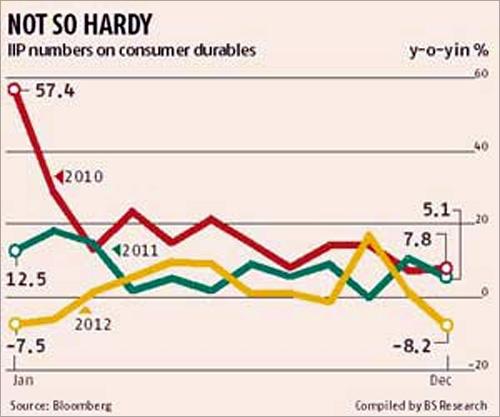 | « Back to article | Print this article |
 The production of durable products (refrigerators, washing machines, air conditioners and conventional television sets) is contracting in India, according to new data released last week.
The production of durable products (refrigerators, washing machines, air conditioners and conventional television sets) is contracting in India, according to new data released last week.
The Index of Industrial Production (IIP) - the country's chief barometer of factory output - released numbers numbers for the month of December 2012. According to these, the consumer durables output declined by 8.2 per cent over the year-ago period - the sharpest fall seen in the 2012 calendar year.
Numbers for previous months were no better. For January, February and September 2012, for instance, the consumer durables output declined 7.5, 6.2 and 1.5 per cent respectively. For the months of March, July, August and November 2012, growth in output was between 0.8 and 1.3 per cent only - paltry when compared with the IIP data for 2011 and 2010 respectively (see chart).
In all, eight of 12 months in 2012 saw negative or low-single digit growth in output — certainly not good news for companies operating in the space.
IIP, for the record, is an indirect indicator of consumer demand. So, why are consumers not picking up durable products as they did earlier?
Shantanu Dasgupta, vice-president, corporate affairs & strategy, Whirlpool, has a ready answer, “The twin impact of shrinking disposable incomes as well as high cost of goods is what is leading to a deferment in purchases of consumer durables.”
Typically, durable products are not perceived to be essential commodities. They are discretionary products, says Dasgupta. “And when purchases can be postponed, consumers are opting to do just that,” points out George Menezes, chief operating officer, Godrej Appliances.
On an average, the replacement cycle for home appliances has increased from two to three years earlier to about four years. “This means consumers are not going for a change even four years after the purchase of their products. This naturally impacts sales,” adds Menezes.
It doesn't help that the price of home appliances has increased by 15-20 per cent in the last one year as the rupee depreciated by 22 per cent.
To tide over this issue, for instance, air conditioner makers, who have been the most hit thanks to both weak sentiment as well as uncertain weather (the last two summers have been cool hitting AC sales) have resorted to desperate measures such as launching knocked-down split air conditioners for as low as Rs 19,000, 32